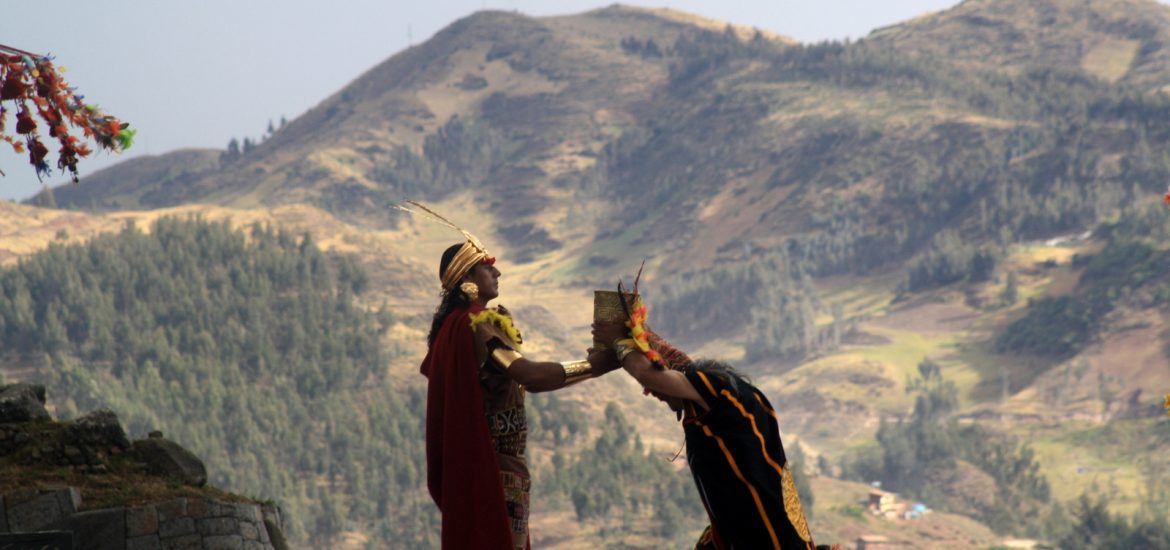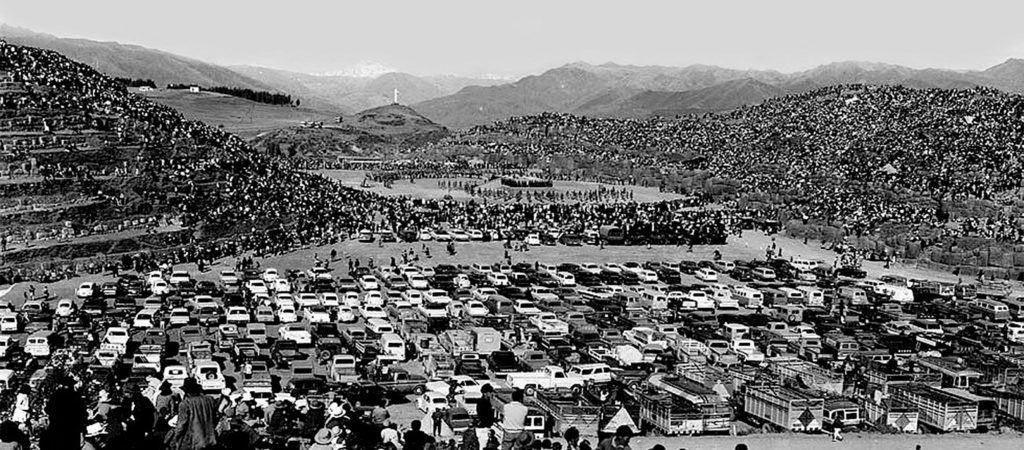Peru is like a large, thick trunk: it is brimming with places, customs, people, food, and events. National and international visitors are waiting to experience them. Consequently, the most observed feast throughout Peru and in the city of Cusco – our Cusco – (is because we are Cusqueños) is “The Inti Raymi.”
However, what exactly is this massive celebration? Why is it still important? How significant was it in Inca times, and today? Why is this event, as the title says, “unforgettable” for Cusqueños and Peruvians? Let’s do a tour to resolve all these questions.
What is Inti Raymi?
The festival of Inti Raymi is the most important Andean celebration. Despite the Spanish conquest, the Inca Empire preserved it. It’s sometimes called the “Festival of the Sun.” Inca Pachacutec established it in 1412 AD to honor the winter solstice and the Sun god “Inti”.
Inca Pachacutec admired and worshipped Inti as the supreme deity. This feast also portrayed the Inca people’s mythical origin: According to the legend, the first Incas in Peru were Manco Cápac and Mama Ocllo, who were both children of the sun.
Historians said that there were three reasons why the Incas celebrated this festival: the first was to recognize the sun god’s gratitude and generosity. The second was to honor the former Inca rulers. The Inca regime saw fourteen Inca rulers, and the people remembered all of them very well.

The third reason was that the rulers wanted people to have a great time with their families, relatives, and friends. People celebrated this party on every corner of the empire, and they held a lavish celebration in the place where the ruler was at that time.
Thousands of domestic and international tourists are drawn to the Inti Raymi. They come for its vibrant cultural display that features hundreds of dancers, musicians, and actors.
This well-known celebration in South America has persisted for centuries, despite the removal of idols mandated during Spanish rule. Every year, on June 24th, during the winter solstice, Inti Raymi is celebrated in Cusco and features a “short” recreation of the Inca rite.
Inti Raymi during Inca times

During the Inca era, many festivals were observed, but none was more significant than the Inti Raymi. The chroniclers say that this celebration was a massive event. It brought together several Andean entities, and each would fully express itself in the grand festival of the Sun.
They had striking headdresses, and vibrant, gaudy clothes adorned in gold and silver, every country in the empire used to send performers. They were singers, actors, and dancers who brought varied customs together annually to celebrate the Sun god.
An Ancient Tradition
No matter where the ruling Inca was based, Inti Raymi was observed across the empire. The key rulers felt obligated to attend the event, not because it was required, but because they were honored to be a part of it and valued the discipline and practicality it offered.
A royal guest was required to send an authorized representative, a brother, son, or other relative if they were unable to attend. Only the “Mamaconas” and “Acllas”, who were Inca maidens and priestesses, were present. They volunteered for rites and joined the closing ceremonies.
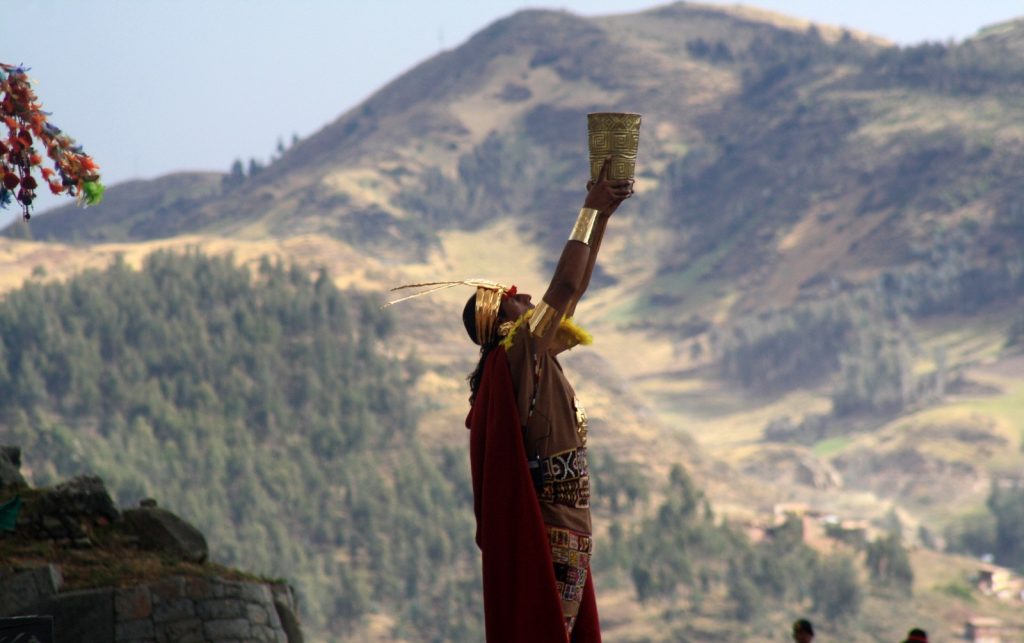
The peasant masses witnessed the festivities from a distance participating in their own ways. So, popular involvement was not completely excluded from this event. Also, the Sun God festival was observed in all the empire’s towns. It was forbidden for people to move from one province to another, so, the regular people could only rejoice with their own.
Since the Inti Raymi is a primarily religious celebration, the Inca, as Son of the Sun, performed the role of High Priest during the opening rites, launching the celebration from the Huacaypata square, now Cusco’s “Plaza de Armas” (Main Square). There, in unison with almost three hundred others, he awaited the dawn with songs that became louder as the first rays of sunlight lit the sky as if they wished to welcome, embrace, and kiss this all-powerful god.

In addition to offering around 100 animal sacrifices to the Sun God, the Viracocha God, and the God of Thunder during the celebration, they made adorations in the “Coricancha” (the temple of the Sun). The Incas also had a practice of putting out all of the city’s bonfires and starting fresh ones that could burn extremely dry straw or cotton directly under the sun. They grilled all the meat that day and burned the sacrifices they had made with this fire.
After that, the emperor would head down to the Huacaypata plaza and spend the rest of the day in contemplation before returning home at night. Finally, the remaining monarchs returned to their kingdoms, marking the end of the Inti Raymi festival. According to chroniclers, the Inti Raymi festival lasted one month during the Inca era, but others disagree, reporting that it lasted between eight and nine days.
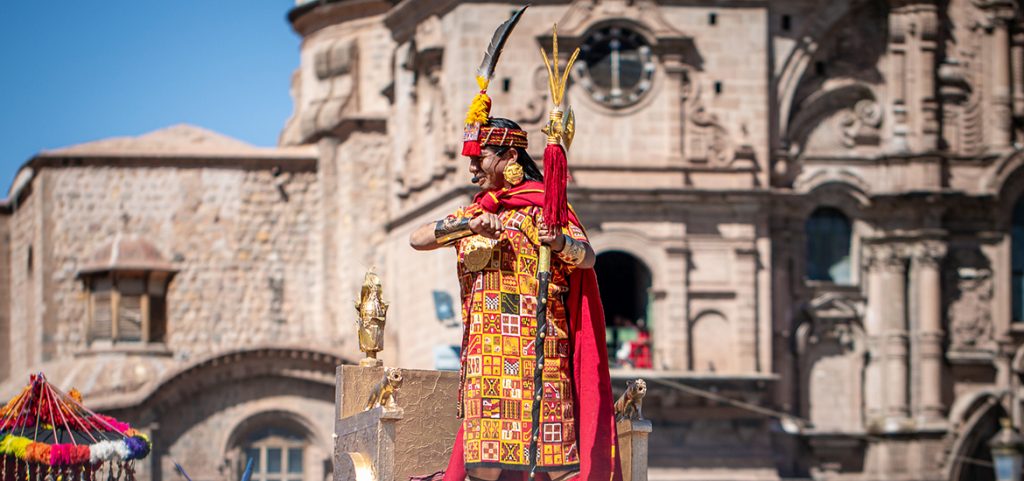
Similarly, the date on which they celebrated this festival might vary depending on when the solstice occurred, so assuming that Inti Raymi was always celebrated on June 24th is completely incorrect. Fortunately, the memory of Inti Raymi did not completely disappear from the Inca town, as its inhabitants kept it in their hearts and continued to celebrate it secretly even after Viceroy Francisco de Toledo’s decree banned it in 1572.
The Inti Raymi festival Nowadays
Today, the celebration of Inti Raymi is one of the cultural heritage Peru has received from the ancient Inca empire. Today, Inti Raymi is the second-largest celebration in South America, after Carnival in Brazil.
The ceremonies of Inti Raymi remained in the heart of the Andean people. But in 1944, the celebration was recovered and shown to the world thanks to Faustino Espinoza Navarro and Humberto Vidal Unda, both Cusqueño writers and Inca history enthusiasts. They recreated the festival based on the work of Inca Garcilaso de la Vega, “Comentarios Reales de los Incas”.
They wrote the first theatrical screenplay for this historic festival, which featured 600 actors. Faustino brought the Inti Raymi to life for 14 consecutive years, and it remains one of the most important events in the Cusco region, drawing guests from all over the world.
Preparation for the Inti Raymi
The Cusco community works together to prepare for Inti Raymi. Months before the occasion, the actors and actresses who will appear in the performance are meticulously chosen. Traditional clothing is created, and extensive rehearsals are held to ensure a flawless production. Furthermore, music and dance workshops are held to help participants hone their skills and give outstanding performances.
Dances play an important part in Inti Raymi because they depict the relationship between humans and nature. Each dance has a specific meaning, ranging from the water dance, which represents fertility, to the fire dance, which represents purification. These dances represent the Inca worldview and are used to communicate with the gods.

Cusco City itself keeps pace in the preparation for this festival. You’ll see the streets decorated with flowers, flags, and elusive items at the party. Historical buildings, ancient sites, and arks are illuminated creating a vibrant and colorful atmosphere. Although is high season, we can say it’s the best time to visit the ancient Inca’s capital as Cusco changes in many ways.
Inti Raymi Mise-en-scène
Inti Raymi staging is an elaborate and complex event in which thousands of musicians, actors, and dancers take part. The portrayal includes live music, dances, Quechua speeches, and more. The most awaited moment is when the “Sapa Inca”, the Inca rulers, get on stage to perform an offering to the sun god.
The spots where the action takes place.
In 2001, Peru named the Inti Raymi a Cultural Heritage and a Ritual Ceremony of National Identity. Since then, people have celebrated Inti Raymi on June 24th. It begins in the Temple of Qoricancha, goes to Cusco’s Plaza de Armas, and ends at the Sacsayhuamán Archaeological Site. Let’s know a little more about this huge festival.

The celebration starts in the Coricancha when the sun hits and begins bathing all of Cusco City. As soon as people see the first sun rays, musicians start singing and playing Andean instruments. They offer camelids, and coca leaves, and wait for the Inca to start the ceremony.
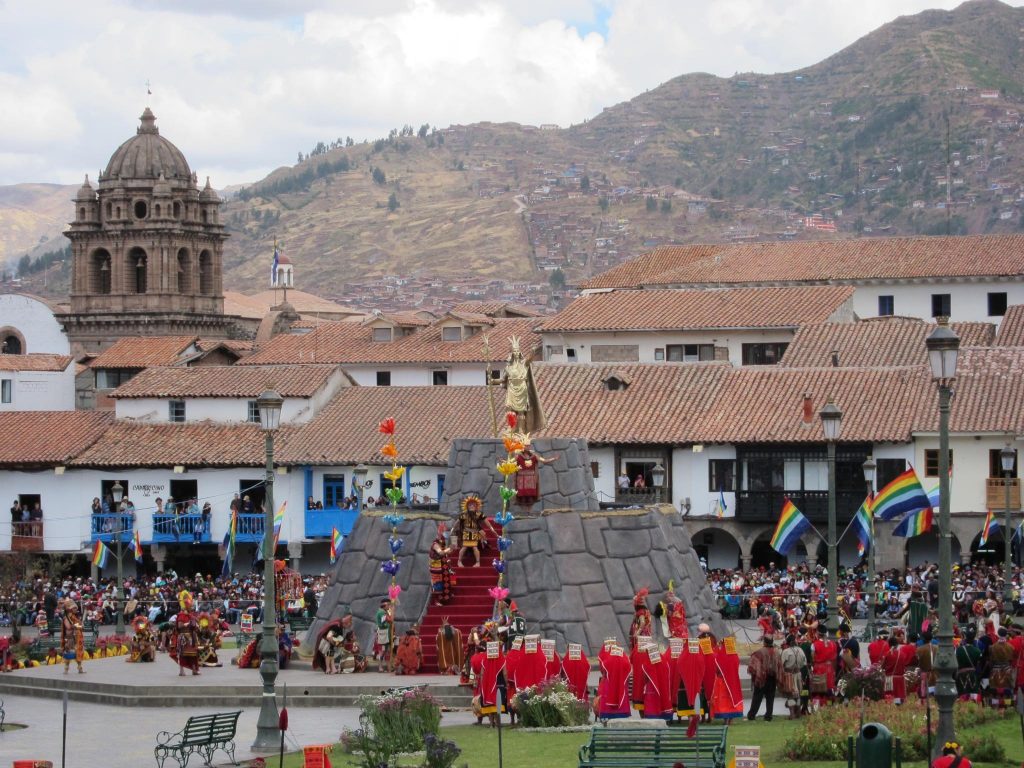
Eight servants carry the Inca around Cusco’s Plaza de Armas, where the coca ritual takes place. This part of the reenactment shows the “meeting of the times”. In it, the Inca entrusts Cusco to its current rulers. The Inca wishes for the city’s prosperity and the care of its people.
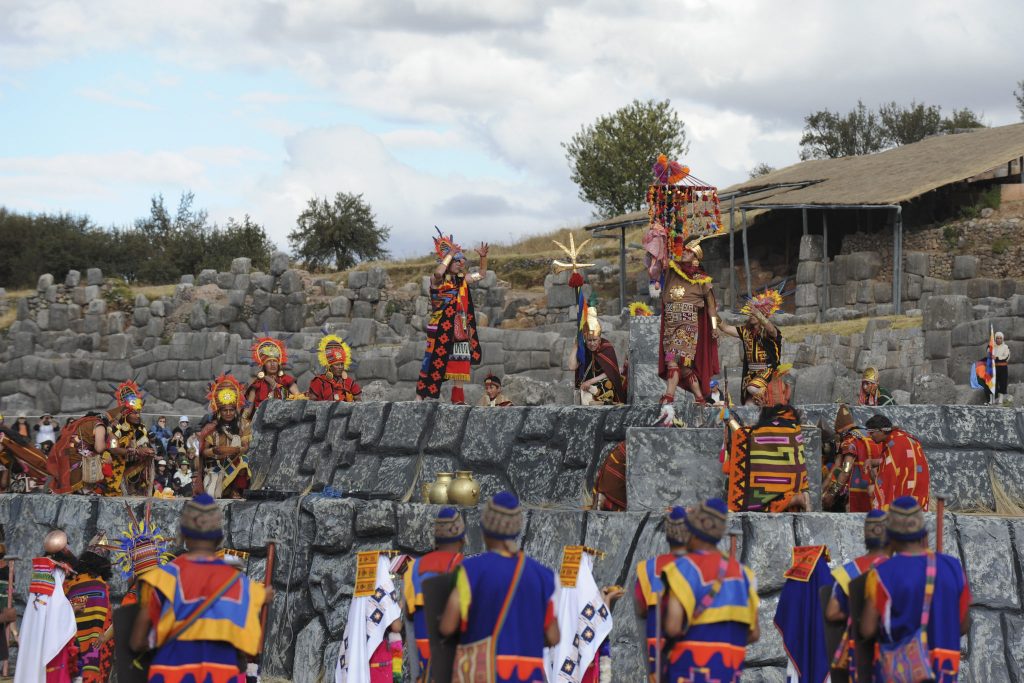
The main Inti Raymi scenario is Sacsayhuamán. The reenactment takes place on the Sacsayhuamán site. Where, in the past, included the sacrifice of a llama. The primary celebration of the festival takes place here, with music and dances of the “four Suyus” (The whole Inca Empire) performed.
Cultural & Social Impact
Inti Raymi is a key cultural celebration in Cusco, Peru. It gives tourists a deep look at Inca history through song and dance. The celebration happens every year on June 24th. It is so important that it has been made a provincial holiday. Most activities and companies in Cusco pause for the occasion. The entire Cusco community contributes to the preparation, which creates jobs and promotes local crafts, local cuisine, and Andean music.
Inti Raymi is a popular tourist destination that attracts thousands of visitors from all over the world. It contributes greatly to the local and national economies. The festival’s attractions include traditional Andean delicacies like “cuy” ( guinea pig ) and “chicharrón” (deep-fried pork), as well as the ceremonial drink “chicha de jora” (Corn Incas’ beer). The event has attracted international attention, with global media coverage sparking interest in Inca culture.
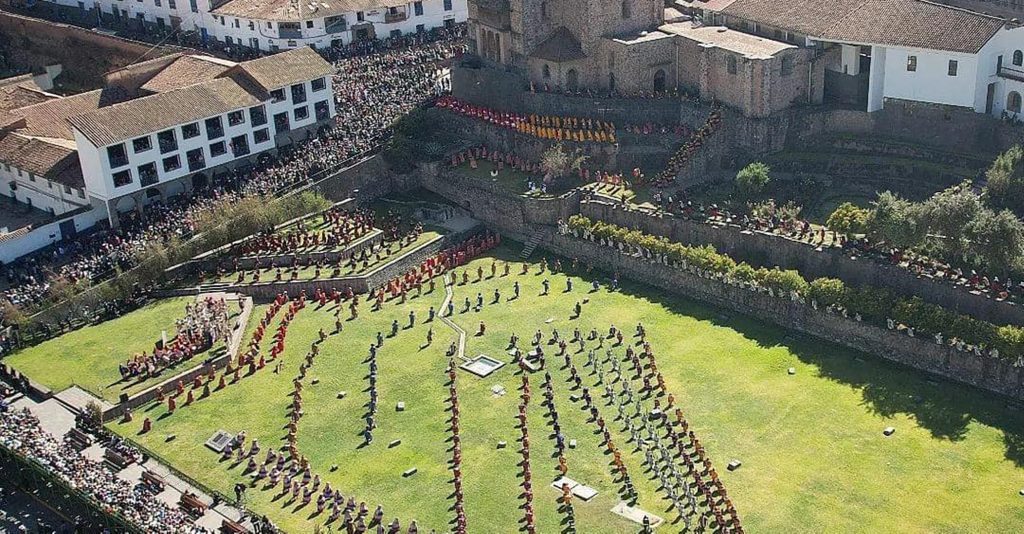
Inti Raymi preserves the Inca civilization’s traditions, beliefs, and culture. It also highlights their engineering, spirituality, and social organization. It is a must-see event for people interested in Peru’s rich past since it demonstrates the Inca empire’s continuing magnificence.
FAQs About the Inti Raymi
What activities can I enjoy during Inti Raymi in Cusco?
During Inti Raymi, you can see the representation in the Plaza de Armas. There are parades, Andean music, and cultural events throughout the city of Cusco.
What is the role of coca leaves in Inti Raymi?
In Andean culture, people use coca leaves in divination rituals. They also offer them to the god Inti, emphasizing their importance.
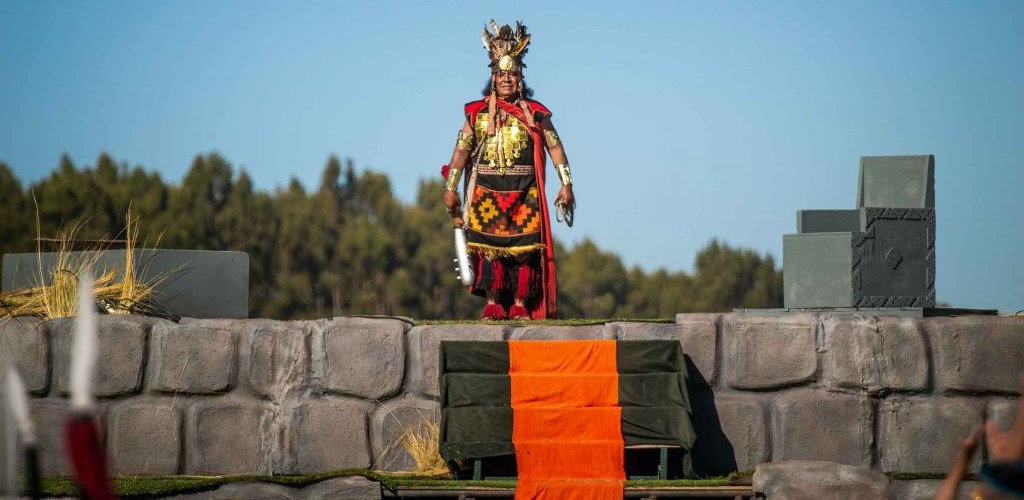
Why is Inti Raymi celebrated on June 24th?
June 24th marks the winter solstice in the southern hemisphere, a significant moment in Inca cosmology. The staging of Inti Raymi represents the sacred connection between the Incas and the sun god, Inti, through rituals and offerings.
How does Inti Raymi contribute to tourism in Cusco?
Inti Raymi is a key tourist attraction as it draws visitors from around the world. This festival creates jobs and promotes local culture in Cusco.

What a ride, huh? We hope now you understand why this celebration is so special for Peruvians and Cusqueños. Inti Raymi transcends time and historical changes, and although some people hindered its celebration, it was alive in people’s hearts and still is in ours. This massive festival is another among several reasons why Peruvians and, especially Cusqueños, are so proud.
As there is only a little more than a month to Inti Raymi, do you feel free to participate? Viagens Machu Picchu can make your dream to visit Cusco and take part in the ancient festival of the sun possible! Contact us right now to experience Inti Raymi, Cusco, and other Peruvian destinations.
Viagens Machu Picchu, journeys that inspire, moments that last.

